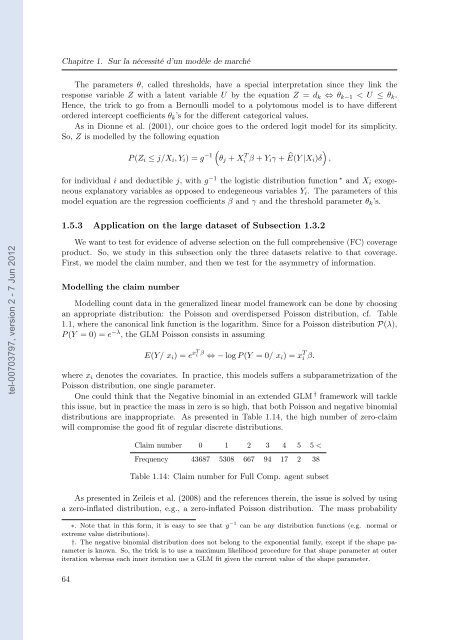Etude des marchés d'assurance non-vie à l'aide d'équilibres de ...
Etude des marchés d'assurance non-vie à l'aide d'équilibres de ...
Etude des marchés d'assurance non-vie à l'aide d'équilibres de ...
Create successful ePaper yourself
Turn your PDF publications into a flip-book with our unique Google optimized e-Paper software.
tel-00703797, version 2 - 7 Jun 2012<br />
Chapitre 1. Sur la nécessité d’un modèle <strong>de</strong> marché<br />
The parameters θ, called thresholds, have a special interpretation since they link the<br />
response variable Z with a latent variable U by the equation Z = dk ⇔ θk−1 < U ≤ θk.<br />
Hence, the trick to go from a Bernoulli mo<strong>de</strong>l to a polytomous mo<strong>de</strong>l is to have different<br />
or<strong>de</strong>red intercept coefficients θk’s for the different categorical values.<br />
As in Dionne et al. (2001), our choice goes to the or<strong>de</strong>red logit mo<strong>de</strong>l for its simplicity.<br />
So, Z is mo<strong>de</strong>lled by the following equation<br />
<br />
−1<br />
P (Zi ≤ j/Xi, Yi) = g θj + X T i β + Yiγ + <br />
E(Y |Xi)δ ,<br />
for individual i and <strong>de</strong>ductible j, with g −1 the logistic distribution function ∗ and Xi exogeneous<br />
explanatory variables as opposed to en<strong>de</strong>geneous variables Yi. The parameters of this<br />
mo<strong>de</strong>l equation are the regression coefficients β and γ and the threshold parameter θk’s.<br />
1.5.3 Application on the large dataset of Subsection 1.3.2<br />
We want to test for evi<strong>de</strong>nce of adverse selection on the full comprehensive (FC) coverage<br />
product. So, we study in this subsection only the three datasets relative to that coverage.<br />
First, we mo<strong>de</strong>l the claim number, and then we test for the asymmetry of information.<br />
Mo<strong>de</strong>lling the claim number<br />
Mo<strong>de</strong>lling count data in the generalized linear mo<strong>de</strong>l framework can be done by choosing<br />
an appropriate distribution: the Poisson and overdispersed Poisson distribution, cf. Table<br />
1.1, where the ca<strong>non</strong>ical link function is the logarithm. Since for a Poisson distribution P(λ),<br />
P (Y = 0) = e −λ , the GLM Poisson consists in assuming<br />
E(Y/ xi) = e xT i β ⇔ − log P (Y = 0/ xi) = x T i β.<br />
where xi <strong>de</strong>notes the covariates. In practice, this mo<strong>de</strong>ls suffers a subparametrization of the<br />
Poisson distribution, one single parameter.<br />
One could think that the Negative binomial in an exten<strong>de</strong>d GLM † framework will tackle<br />
this issue, but in practice the mass in zero is so high, that both Poisson and negative binomial<br />
distributions are inappropriate. As presented in Table 1.14, the high number of zero-claim<br />
will compromise the good fit of regular discrete distributions.<br />
Claim number 0 1 2 3 4 5 5 <<br />
Frequency 43687 5308 667 94 17 2 38<br />
Table 1.14: Claim number for Full Comp. agent subset<br />
As presented in Zeileis et al. (2008) and the references therein, the issue is solved by using<br />
a zero-inflated distribution, e.g., a zero-inflated Poisson distribution. The mass probability<br />
∗. Note that in this form, it is easy to see that g −1 can be any distribution functions (e.g. normal or<br />
extreme value distributions).<br />
†. The negative binomial distribution does not belong to the exponential family, except if the shape parameter<br />
is known. So, the trick is to use a maximum likelihood procedure for that shape parameter at outer<br />
iteration whereas each inner iteration use a GLM fit given the current value of the shape parameter.<br />
64
















